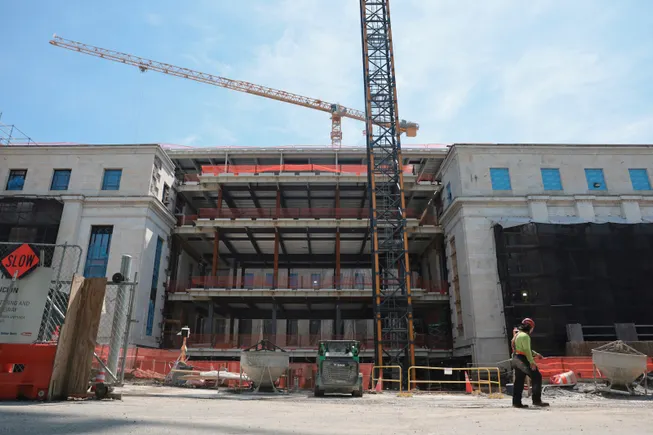In the first half of the year, one word continued to appear in headlines surrounding broad economic and political change: “uncertainty.” Construction Dive’s Uncertainty Series delves into how this lack of clarity is affecting contractors and what the future holds. Read the previous article here.
In a construction market hungry for clarity, even a hint of positivity could unlock building momentum.
That’s the hope among contractors who say the path forward in nonresidential construction has grown murky. Although planning activity ticked up in June, uncertainty around interest rates continues to hamstring the number of groundbreakings.
“Many commercial builders have developed a wait-and-see approach to planning and starting new projects until borrowing costs come down,” said Brian Schmidt, senior director of economic policy and analytics at the American Cement Association, a Washington, D.C.-based trade group. “Going into 2025, most developers expected interest rates to continue to decline throughout the year. Now tariffs have introduced new uncertainty for both material price escalation concerns and the pace at which interest rates will come down.”
Delayed expectations have already shaken the project pipeline. ConstructConnect, a Cincinnati-based construction data provider, noted a spike in on-hold and canceled projects, according to its Project Stress Index.
“We have seen surges in the number of delayed, on-hold and abandoned projects when generally held interest rate expectations no longer align with reality,” said Michael Guckes, chief economist at ConstructConnect. “In both late 2023 and even more so in late 2024, the industry realized that elevated inflation would keep rates higher for longer than previously expected.”
Even contractors with strong backlogs report growing concern about the future. Many fear for a drop-off once their current workload dries up, said Anirban Basu, chief economist at the Associated Builders and Contractors.
“For the most part, people are pretty busy in construction, but they’re nervous in many cases about that backlog in 2026 or 2027,” said Basu. “Not as many new deals are being signed, and it’s become more difficult to win bids because they’re more competitors in every bid.”
Waiting for a pivot
As contractors continue to hope for a Federal Reserve pivot to cuts, most analysts now anticipate only modest action this year, if any at all. The most recent June inflation data posted higher than expected readings, adding doubt to a future slash.
“We do not expect a meaningful turning point in 2025. The Federal Reserve has stated that they would likely have cut rates by now if it were not for the tariff uncertainty,” said Schmidt. “Even with one or two 25 basis point cuts, monetary policy will still be restrictive. It will matter more as a signal to builders that the Federal Reserve is willing to start reducing rates again.”
The construction industry continues to absorb higher expenses on two fronts, namely construction costs and elevated borrowing costs. These dynamics compound delays, especially for revenue-dependent projects, said Guckes.
“Higher rates are negatively impacting net operating income expectations for current and prospective developers and owners,” said Guckes. “Higher rates also elevate construction and operating costs all along the supply chain from building product manufacturers to general contractors and trade contractors when they are borrowing capital for their operating needs.”
That pressure has forced developers to revisit the viability of certain work. Several projects in planning stages relied on expected rate cuts in the first half of 2025, said Schmidt.
“Projects currently in the planning phase might have financial projections based on certain interest rate assumptions,” said Schmidt. “Those assumptions may no longer hold water, which could result in those projects to be put on hold or potentially scaled back.”
Contractors want a sign
Despite these headwinds, economists say just a tone shift could ignite construction activity.
“If nonresidential builders knew there was light at the end of the tunnel, they could start planning projects in a more robust manner sooner,” said Schmidt.
But uncertainty may not deserve all the blame, said Ken Simonson, chief economist at the Associated General Contractors of America. He said current interest rates, not the lack of clarity, were the core challenge.
“The rate itself, not uncertainty about it, has held down construction of income-dependent projects,” said Simonson. “The higher cost of funds means owners must charge higher rents or room rates for a project to pencil out.”
At the same time, inflation continues to weigh on expectations. Rising input costs for materials add another layer of uncertainty for contractors’ books.
“We saw a lot of inflation facing contractors purchasing intermediate goods,” said Basu. “That ultimately can be an indication that eventually we’re going to see even more construction inflation going forward.”
The result is a cautious outlook for the second half of 2025. Contractors still hold strong pipelines today, but many are increasingly indicating the math looks tougher the further out they go.
“To move forward with a construction project requires a certain level of certainty on the part of the project owner,” said Basu. “We don’t have that right now.”
View the original article and our Inspiration here


Leave a Reply